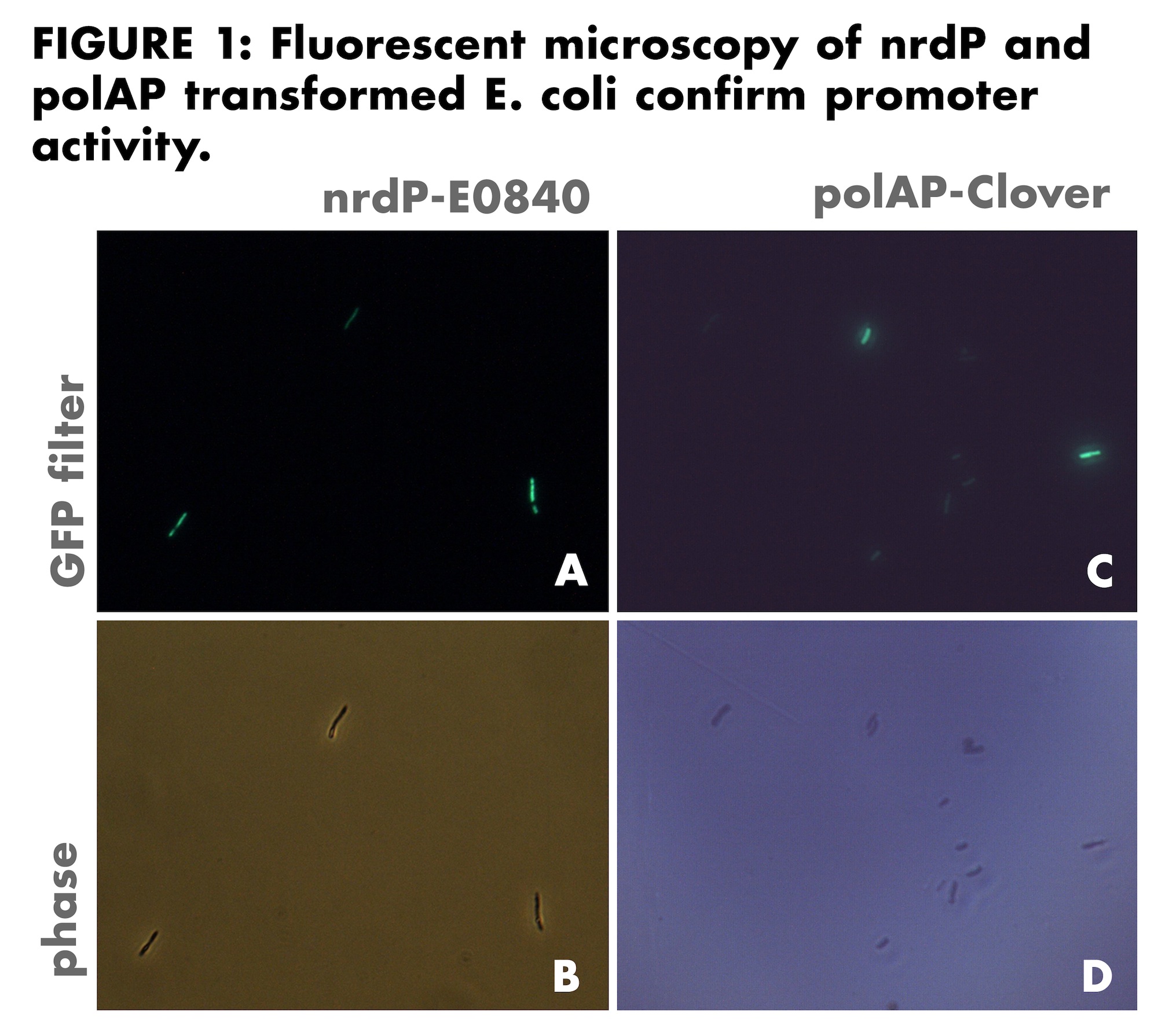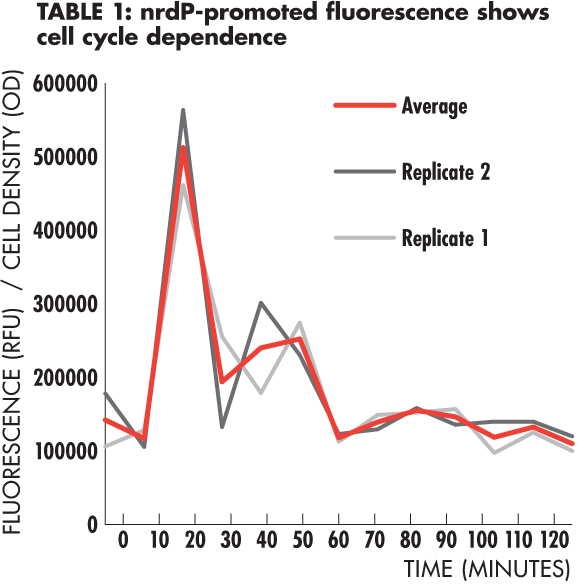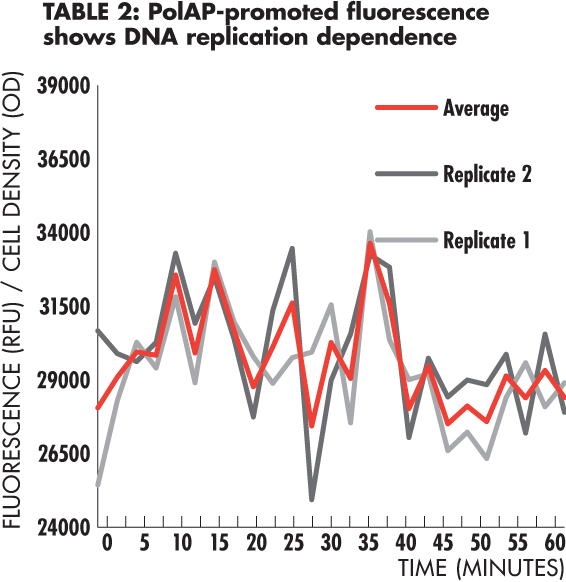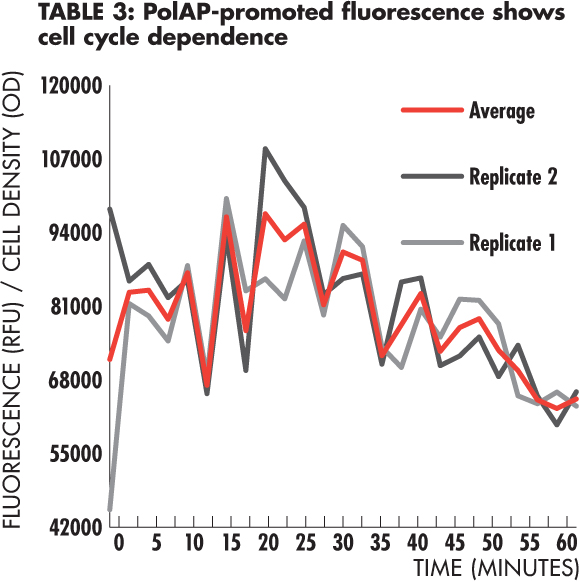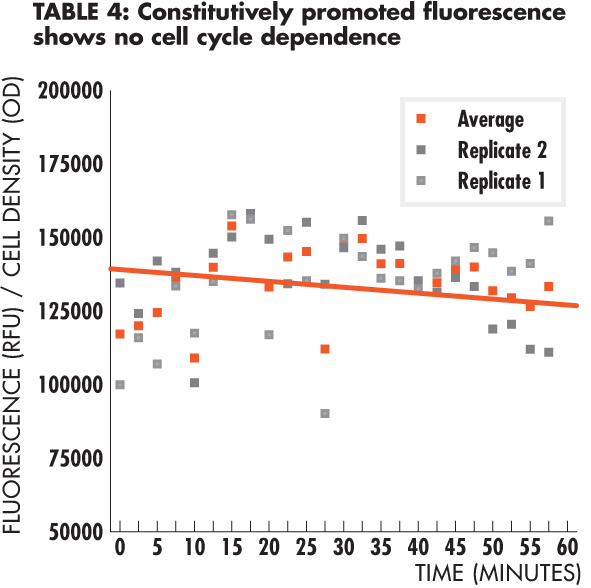Team:Stanford-Brown/VenusLife/Biosensing
From 2012.igem.org
Remote Biosensing
We Biobricked novel cell-cycle dependent promoters! But why are they important?
In order to explore hypotheses of aerosolized Venusian life, we must implement a means to observe growth in situ. Since we are ultimately interested in whether or not organisms can inhabit a certain (extraterrestrial) niche, our organisms must exhibit a reporter for growth, not survivability. Since bacteria can sporulate or enter bacteriostasis under stress, thereby surviving without growing or reproducing, it is important to distinguish bacterial growth or reproduction as an indicator of successful inhabitation.
It is necessary that researchers can measure such a reporter without interfering with an ongoing experiment. In the case of our project, which utilizes an adapted Millikan apparatus as a suspension chamber to aerosolize bacteria, it would be impossible to observe the aerosolized bacteria except through a viewing scope. Normal techniques of quantifying growth and replication, such as FACS or measuring optical density via spectrophotometry, would not be useful. As such, we decided to design and create a fluorescent cell-cycle dependent reporter to enable optical analysis of organisms in situ. Such a reporter transcends use in this isolated experiment in the lab; researchers using organisms that express this reporter can use fluorescence to measure growth rates without disturbing their sample.
In order to engineer this cell-cycle dependent reporter, we first require a cell-cycle dependent promoter. We identified two from literature that we describe at this time:
polA promoter (polAP) - BBa_K847210
DnaA is the central initiator of DNA replication in E. coli and other prokaryotic organisms, but importantly, it also functions as a transcription factor that can suppress or activate transcription of genes by binding to the DnaA box, a 9bp consensus sequence (Messer 1997). Since DnaA expression is dependent on the growth conditions of the cell (Chiaramello 1990), genes regulated by DnaA are transitively growth dependent. One such DnaA-dependent gene is polA, which codes for DNA Polymerase I, active in DNA replication (Quiñones 1997).
nrd promoter (nrdP) - BBa_K847211
The nrd operon in E. coli expresses ribonucleotide reductase, an enzyme that reduces ribonucleotides into deoxyribonucleotides and is involved in bacterial cell cycle (Sun 1994). The promoter for this operon was found to begin activation during initiation of DNA replication and is cell-cycle dependent (Sun 1992).
The nrd promoter also contains several DnaA boxes (Messer 1997); however, this does not seem to necessitate that nrdP is related to DNA synthesis rate, as DnaA indirectly controls cell division (Messer 2002).
These promoters, once isolated from their host E. coli genome and reconstituted synthetically, drive expression of fluorescent proteins such as GFP (green fluorescent protein) in our reporter. The transformation of this device into E. coli confers this biological tool that allows for in situ measurement of growth.
Results/Discussion
Potential cell-cycle dependent promoters in E. coli and their sequences were identified from literature (Quiñones 1997, Sun 1994, Bates 1997) and isolated using Colony PCR (Protocols). We developed our constructs for assay by ligating these PCR products in front of BBa_E0840, which consists of RBS BBa_B0030, reporter BBa_E0040 (mut3b GFP), and terminator BBa_B0015.
Our constructs displayed fluorescence when transformed into NEB-5alpha competent cells. While nrdP-E0840 displayed sufficient fluorescence as verified by fluorescent microscopy, the original polAP-E0840 construct (which uses mut3b GFP) exhibited low expression; while fluorescence was visible under the microscope, the signal was too weak for the camera to recognize. The polA promoter was therefore digested with EcoRI and SpeI then ligated into plasmid pNCS containing a RBS, Clover, and a terminator. Clover is a highly engineered green fluorescent protein that exhibits extreme brightness (Lam 2012). This sufficiently bright polAP-Clover construct, along with the original nrdP-E0840 construct, are displayed in Figure 1.
Figure 1 indicates that the sequences we isolated constitute promoter sequences. Since the sequences were ligated into a vector consisting of a ribosomal binding site (RBS), gene for GFP, and terminator, without a promoter it will not produce fluorescence. Since ligation upstream of the RBS resulted in fluorescence and negative control (vector without promoter insert) displays no leaky fluorescence, we can conclude that we successfully isolated promoters for nrdP and polAP.
With promoter activity qualitatively demonstrated, we now turn to characterization of these promoters’ cell-cycle dependency. To assay this characteristic, we used a bulk assay in which we use serine hydroxamate (SHX) to synchronize the cell cycles of a sample (Ferullo 2009), wash the cells of SHX, then incubate the sample at 37C while taking periodic optical density and fluorescence readings (Protocols). The results of these bulk assays are presented here.
nrdP is cell-division dependent!
In other words: we can use nrdP to tell us when our cells are dividing, which they only do when they are happy and growing!
The fluorescence reporter strain is mut3b GFP, which has a half-life of 33 hours. Since cell-cycle is on an order far less than 33 hours (~20 minutes), the fluorescence should not significantly decrease during the 1-2 hours of the microscope or bulk assays. Therefore, we expect a stepwise function in fluorescence readings (RFU). This matches the fluorescence reflected in the nrdP bulk assay, illustrated in Table 1.
When the fluorescence reading is divided against cell density, we expect a roughly sinusoidal graph: fluorescence increases as initiation of cell replication begins, then decreases as optical density increases at a greater rate than expression of fluorescence. The intensity of the signal is expected to decrease as time increases because the synchronization from the SHX wears off after 2-3 cell cycles. The plotted ratio data follows such sinusoidal behavior; replication events are clearly visible right before t=20 and t=40, suggesting that promoter activity is cell-cycle dependent.
polAP is DNA-replication dependent!
In other words: we can use polAP to tell us when our cells are replicating their DNA, which they only do when they are happy and growing!
Under optimal conditions, K12 E. coli will initiate DNA replication about every 10 minutes, given that a cell replicates about every 20 minutes and must account for a 40 minute chromosomal replication time (Grant 2011). Our results show oscillations at around a 10 minute period. Given that we grew our strains in fresh medium (LB) in a shaking 37C incubator, which constitutes near-optimal conditions, we can conclude that we expect ~10 minute period oscillations. From this we determine that the results suggest that our polAP promoter exhibits DNA-replication dependence, as shown in Table 2 and 3.
Control run
To obtain a baseline for our results, we ran a control sample: a strain that constituitively expresses mut3b GFP, the same variant of GFP used in our experimental constructs. Due to constituitive expression, the expectation is that fluorescence should follow linear behavior. This is the result of the control bulk assay, as indicated in Table 4.
Conclusion
Our assays via microscopy and the bulk assay shows that our promoters are functional as cell-cycle dependent tools. The application of such tools are widespread and certainly not limited to astrobiology; we could use nrdP to empirically determine doubling times and could possibly extrapolate DNA content from intensity of signals expressed by polAP. However, we are first and foremost interested in its use in astrobiology, and this use is clear too. In the immediate case, we plan to use these promoters in reporters expressed in bacteria that we will aerosolize into a suspension chamber. The presence of similar oscillations in fluorescence that we observed in the bulk assay would suggest that bacteria can reproduce in aerosol and therefore inhabit a niche in the clouds. Applying this use further, similar remote biosensing could be used in an experiment in the clouds of Venus itself, where observers could potentially detect certain fluorescence readings remotely rather than having to scour the hellish Venusian clouds to capture some bacteria for a Western blot. Thus, we suggest promoter tools like nrdP and polAP present a broad range of possibilities to researchers, especially in the new application of synthetic astrobiology.
Sources:
Messer M., Weigel C.: DnaA initiator - also a transcription factor. Molecular Microbiology 1997, 24:1-6.
Chiaramello A.E., Zyskind, J.W.: Coupling of DNA replication to growth rate in Escherichia coli: A possible role for guanosine tetraphosphate. J. Bacteriology 1990, 172:2013-2019.
Quiñones A., Wandt G., Kleinstauber S., Messer W.: DnaA protein stimulates polA gene expression in Escherichia coli. Molecular Microbiology 1997, 23: 1193-1202.
Sun L., Jacobson B., Dien B., Srienc F., Fuchs J.: Cell Cycle Regulation of the Escherichia coli nrd Operon: Requirement for a cis-Acting Upstream AT-Rich Sequence. J. Bacteriology 1994, 176: 2415-2426.
Sun L., Fuchs J.: Escherichia coli Ribonucleotide Reductase Expression is Cell Cycle Regulated. Molecular Biology of the Cell 1992, 3:1095-1105.
Messer W.: The bacterial replication initiator DnaA. DnaA and oriC, the bacterial mode to initiate DNA replication 2002, 26:355-374.
Lam A., St-Pierre F., Gong Y., Marshall J.D., Cranfill P.J., Baird M.A., McKeown M.R., Wiedenmann J., Davidson M.W., Schnitzer M., Tsien R.Y., Lin M.Z.: Improved dynamic range of genetically encoded FRET sensors with bright new green and red fluorescent proteins. Nature Methods 2012, 9:1005-1012.
Ferullo D.J., Cooper D.L., Moore H.R., Lovett S.T.: Cell cycle synchronization of E. coli using the stringent response, with fluorescence labeling assays for DNA content and replication. Methods 2009, 48:8-13.
Grant M.A.A., Saggioro C., Ferrari U., Bassetti B., Sclavi B., Lagomarsino M.C.: DnaA and the timing of chromosome replication in Escherichia coli as a function of growth rate. BMC Systems Biology 2011, 5:201.
 "
"
